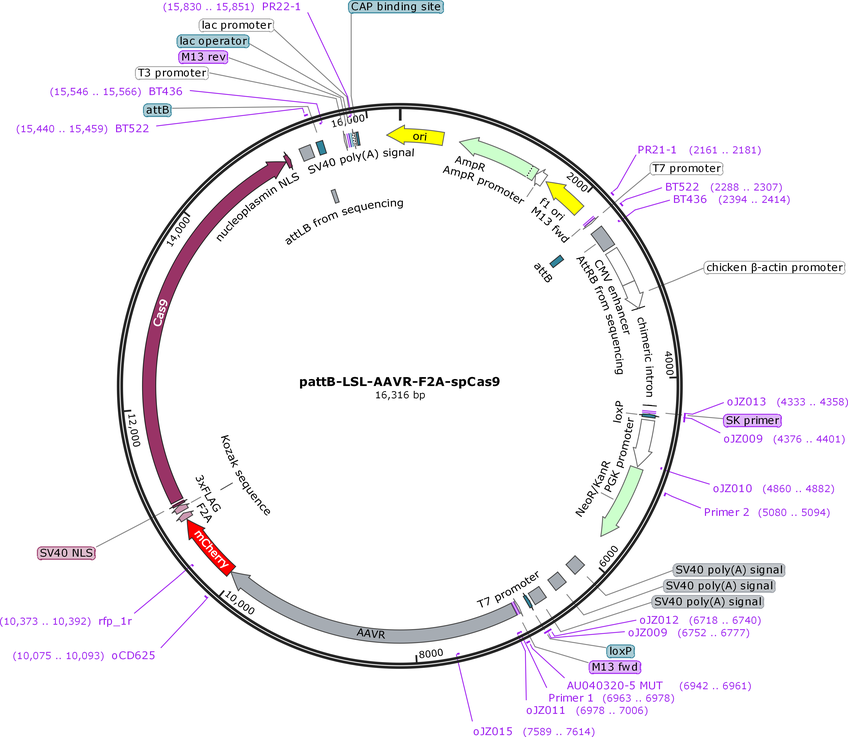pattB-LSL-AAVR-F2A-spCas9
(Plasmid
#202459)
-
PurposeThe plasmid backbone used to generate the recombination template to generate the SELECTIV mice through Integrase Mediated Transgenesis. Allows for Cre-dependent expression of AAVR and Cas9.
-
Depositing Lab
-
Sequence Information
Ordering
| Item | Catalog # | Description | Quantity | Price (USD) | |
|---|---|---|---|---|---|
| Plasmid | 202459 | Standard format: Plasmid sent in bacteria as agar stab | 1 | $85 | |
Backbone
-
Vector backbonepBT378, Addgene, cat#52554
-
Backbone manufacturerLiqun Luo
- Backbone size w/o insert (bp) 5510
- Total vector size (bp) 16316
-
Modifications to backbonePreviously modified by Monte Winslow to express Streptococcus pyogenes Cas9 (spCas9) with a LSL sequence proceeding to generate paatB-LSL-spCas9.
-
Vector typeMammalian Expression, Mouse Targeting, Cre/Lox, CRISPR
-
Selectable markersNeomycin (select with G418)
Growth in Bacteria
-
Bacterial Resistance(s)Ampicillin, 100 μg/mL
-
Growth Temperature37°C
-
Growth Strain(s)DH5alpha
-
Copy numberHigh Copy
Gene/Insert
-
Gene/Insert nameAAVR
-
Alt nameAU040320
-
Alt nameKiaa0319L
-
SpeciesM. musculus (mouse)
-
Insert Size (bp)3144
-
Entrez GeneAU040320 (a.k.a. A730047D20Rik, AAVR, Kiaa0319l)
- Promoter CAG
-
Tag
/ Fusion Protein
- mCherry fusion (C terminal on insert)
Cloning Information
- Cloning method Gibson Cloning
- 5′ sequencing primer gtaaaacgacggccagt
- 3′ sequencing primer gtcatagctgtttcctg (Common Sequencing Primers)
Resource Information
-
Supplemental Documents
Terms and Licenses
-
Academic/Nonprofit Terms
-
Industry Terms
- Not Available to Industry
Trademarks:
- Zeocin® is an InvivoGen trademark.
These plasmids were created by your colleagues. Please acknowledge the Principal Investigator, cite the article in which the plasmids were described, and include Addgene in the Materials and Methods of your future publications.
-
For your Materials & Methods section:
pattB-LSL-AAVR-F2A-spCas9 was a gift from Jan Carette (Addgene plasmid # 202459 ; http://n2t.net/addgene:202459 ; RRID:Addgene_202459) -
For your References section:
Hardwiring tissue-specific AAV transduction in mice through engineered receptor expression. Zengel J, Wang YX, Seo JW, Ning K, Hamilton JN, Wu B, Raie M, Holbrook C, Su S, Clements DR, Pillay S, Puschnik AS, Winslow MM, Idoyaga J, Nagamine CM, Sun Y, Mahajan VB, Ferrara KW, Blau HM, Carette JE. Nat Methods. 2023 Jul;20(7):1070-1081. doi: 10.1038/s41592-023-01896-x. Epub 2023 Jun 8. 10.1038/s41592-023-01896-x PubMed 37291262





